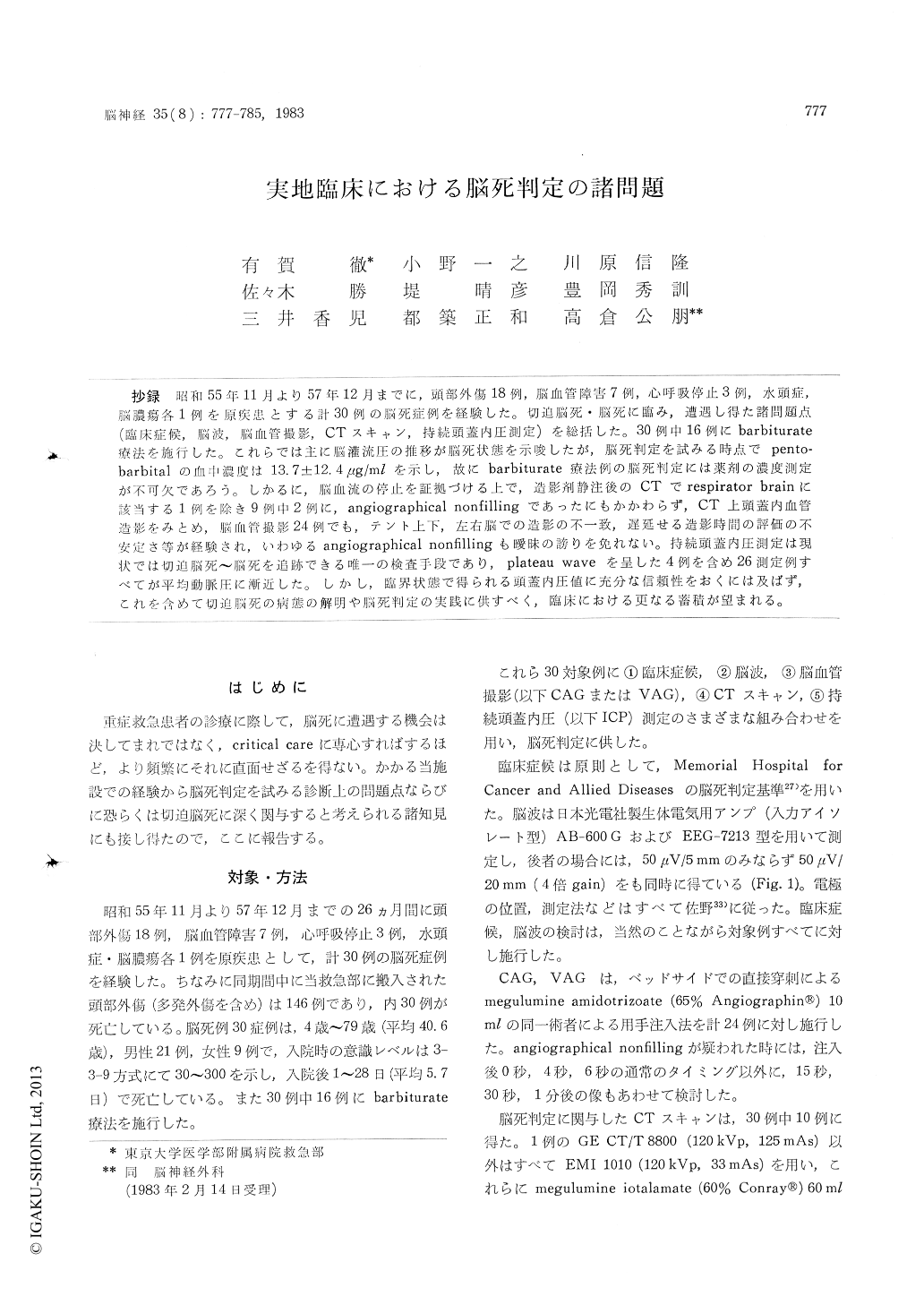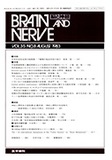Japanese
English
- 有料閲覧
- Abstract 文献概要
- 1ページ目 Look Inside
抄録 昭和55年11月より57年12月までに,頭部外傷18例,脳血管障害7例,心呼吸停止3例,水頭症,脳膿瘍各1例を原疾患とする計30例の脳死症例を経験した。切迫脳死・脳死に臨み,遭遇し得た諸問題点(臨床症候,脳波,脳血管撮影,CTスキャン,持続頭蓋内圧測定)を総括した。30例中16例にbarbiturate療法を施行した。これらでは主に脳灌流圧の推移が脳死状態を示唆したが,脳死判定を試みる時点でpento—barbitalの血中濃度は13.7±12.4μg/mlを示し,故にbarbiturate療法例の脳死判定には薬剤の濃度測定が不可欠であろう。しかるに,脳血流の停止を証拠づける上で,造影剤静注後のCTでrespiratorbrainに該当する1例を除き9例中2例に,angiographical nonfiilingであったにもかかわらず,CT上頭蓋内血管造影をみとめ,脳血管撮影24例でも,テント上下,左右脳での造影の不一致,遅延せる造影時間の評価の不安定さ等が経験され,いわゆるangiographicalnonfillingも曖昧の謗りを免れない。持続頭蓋内圧測定は現状では切迫脳死〜脳死を追跡できる唯一の検査手段であり,plateau waveを呈した4例を含め26測定例すべてが平均動脈圧に漸近した。しかし,臨界状態で得られる頭蓋内圧値に充分な信頼性をおくには及ばず,これを含めて切迫脳死の病態の解明や脳死判定の実践に供すべく,臨床における更なる蓄積が望まれる。
The authors experienced thirty brain deaths including eighteen head injuries and seven cereb-rovascular accidents during the period from Nov. 1980 to Dec. 1982 and encountered with some practical problems on clinical diagnosis of brain death.
In sixteen patients subjected to barbiturate (pentobarbital) therapy, the attempt to meet the criteria of brain death made it necessary to con-firm the total cerebrocirculatory arrest as well as to measure the serum concentration of pentobar-bital and assure its level low enough. But as a result of the angiograms performed in twenty-four cases the cerebral angiography sometimes failed to give sufficient evidence to confirm it not merely because of the angiographical intracranial delayed opacification but also because of the dissociation of filling between supra-and infratentorial spaces or between right and left hemispheres. And besides the contrast enhancement of cerebral vessels wasverified in computed tomograms of two cases among ten cases who had already met the criteria and demonstrated angiographical nonfilling pheno-menon.
The angiographical narrowing of C 1-2, A 1, M 1 portions or basilar artery observed on serial angiograms preceding the angiographical nonfilling phenomenon was regarded as direct vascular com-pression by cerebral swelling or vasospasm and considered to suggest that brain death might be impending. At present the continuous monitoring of intracranial pressure performed in twenty-six cases proved to be a convincing guide to suspicion of brain death or impending brain death according to decrease in cerebral perfusion pressure and appearance of so-called plateau waves recorded in four cases.
The pathophysiological explication of impending brain death is now out of the question but should be elucidated to solve the above mentioned pro-blems.

Copyright © 1983, Igaku-Shoin Ltd. All rights reserved.


